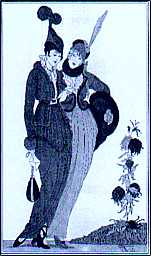Collecting
Fashion Plates
By
Nancy Lyons and Jane Carr
Fashion plates originated in the late 18th century when Costumes Parisiens and The Ladies Magazine and others suddenly started presenting beautifully engraved illustrations of women wearing the latest fashions. Fairly plain by modern standards, they were black and white, and pictured the fashionable models of the day in "haute couture" clothing without any special props or backgrounds.
Not surprisingly, soon after a wide variety of ladies fashion magazines appeared with fashion plates. By the mid-1800's hand-colored fashion plates peaked in popularity; they didn't disappear until after the 1920's.

|
| Journal des Dames et des Modes |
Fashion plates can be found in such magazines as La Gazette du Bon Ton, The Standard Designer, Gallery of Fashion, Godey's Lady's Book, The Englishwoman's Domestic Magazine, The Young Ladies' Journal, and The Delineator.
Some of the most beautiful engraved copperplate fashion illustrations could be found in the Journal des Dames et des Modes (known simply as La Mésangère) from June 1912 - August 1914. During this heyday of French fashion houses, La Mésangère showcased some of the most outstanding artists and designers: Georges Barbier, Bernard Boutet de Monvel, Charles Martin, Francisco Javier Gosé, Rober Pichenot, and later Maurice Taquoy and Umberto Brunelleschi. Colour, patterns and graceful lines in these plates depicted elegance and opulence in outfits appropriate for many occasions and times of day. Grace and style were punctuated with drapped clothing, furs, feathers and jewels.
Fashion plates form an important record of an era. As La Mésangère was a luxury magazine for an exclusive clientele, only 1279 copies of each issue were printed. The text included poetry and fashion notes written by distinguished contributers such as Jean Cocteau. Each issue included up to five unbound coloured fashion plates; a total of 184 in all.
 |
| Journal des Dames et des Modes |
Fashion plates from any magazine are considered collectible as long as they are in good condition. Unfortunately, many plates have already been removed from their magazines. While this does not usually affect the value of the plates, finding plates intact in their original magazine would be preferable.
When choosing magazines or plates to add to your collection, avoid those that have rips or tears, discoloring, fading or crinkling. If you purchase plates which have been removed from magazines, be sure they have been cut and not ripped out. If the plate is framed, always remove it and reframe it with ultra-violet protection glass as this will keep it from fading. If you choose not to, store them in an archival-quality box, file or scrapbook.
Fashion plates from all periods may be readily found in antique and paper collectable stores, as well as through antiquarian book dealers. But the best bargains can usually be found at flea markets and estate sales, where sellers might not know the worth of old magazines and fashion plates. Sometimes a good deal can also be found at auctions, where old magazines and papers may end up in a lot box with other, more popular items. Whatever price you pay for your plates or magazines, their beauty and historical significance are sure to increase their value in the future.